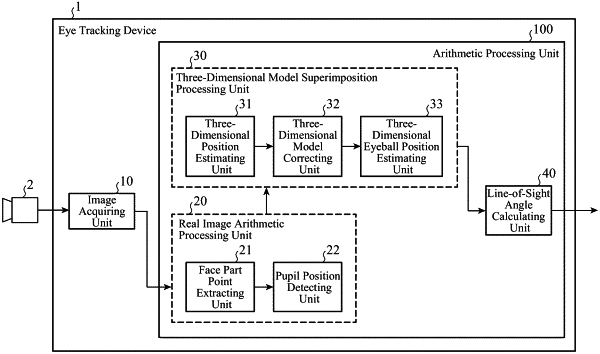| CPC G06F 3/013 (2013.01) [G06T 7/73 (2017.01); G06T 17/00 (2013.01); G06V 40/18 (2022.01); G06T 2207/10028 (2013.01); G06T 2207/30201 (2013.01)] | 1 Claim |

|
1. An eye tracker comprising:
an image acquirer to acquire an image of a subject;
an arithmetic processor to perform image processing; and
a line-of-sight angle calculator to calculate a line-of-sight direction vector by referring to a result of the image processing, wherein
the arithmetic processor includes: a real image arithmetic processor to perform arithmetic processing on a real image in an image space; and a three-dimensional model superimposition processor to perform superimposition processing on the image space using a three-dimensional face model, and
the three-dimensional model superimposition processor includes an eyeball position corrector to estimate a direction of the pupil by referring to a distance from a nose point N to a pupil,
the eyeball position corrector
(processing A) coordinate-transforms a plurality of reference points defined on the three-dimensional face model to an image coordinate system,
(processing B) corrects the position of a point A, which is one of the reference points, and defines as a point A′,
(processing C) decomposes a vector NA′ connecting the nose point N and the defined point A′ in an X-axis direction and a Y-axis direction, and
(processing D) calculates a distance from the nose point N to the pupil position by referring to the decomposed Y-axis direction component of the vector NA′,
wherein, the X-axis direction in the image coordinate system is generally horizontal, and the Y-axis direction in the image coordinate system is generally vertical.
|